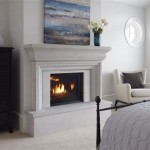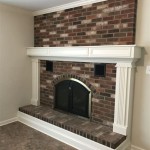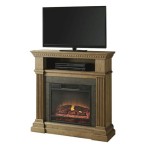The Enduring Appeal of the Fireplace Corner Mantel
The fireplace, a traditional focal point in homes, has evolved in design and function over centuries. Among the various fireplace configurations, the corner fireplace presents a unique architectural challenge and opportunity. Accentuating this focal point with a well-chosen mantel elevates the room's aesthetic, providing both visual appeal and practical functionality. The fireplace corner mantel, therefore, becomes a key element in shaping the overall ambiance and style of the living space.
The strategic placement of a fireplace in a corner often arises from space constraints or a desire to create a more intimate setting. Unlike a traditional fireplace centered on a wall, a corner fireplace commands attention from multiple angles. This positioning necessitates a mantel design that complements the room's architecture and effectively balances the visual weight of the entire fireplace structure. Considerations such as viewing angles, furniture placement, and overall room flow all play a crucial role in selecting the ideal corner mantel design.
The function of a corner mantel extends beyond mere aesthetics. It serves as a display area for decorative items, a practical surface for seasonal accents, and a structural element that defines the fireplace as a distinct architectural feature. Furthermore, the mantel provides a safety barrier, shielding individuals from the direct heat emanating from the firebox. The selection of materials, dimensions, and style of the corner mantel should therefore reflect both the practical needs and the desired aesthetic impact.
Key Considerations for Corner Mantel Design
Designing a corner mantel requires careful consideration of several key factors to ensure a visually appealing and functionally sound outcome. These elements include understanding the architectural context, selecting appropriate materials, and choosing a style that complements the overall design scheme of the room.
The architectural context refers to the existing style and features of the room. Is the room traditional, contemporary, rustic, or eclectic? The mantel should seamlessly integrate with the existing architectural elements rather than clashing with them. For example, a sleek, minimalist mantel would be more appropriate for a contemporary space, while a more ornate and detailed mantel would be better suited for a traditional or Victorian-style room. Analyzing the room's lines, moldings, and overall character is paramount in determining the appropriate mantel design.
The selection of materials significantly impacts the overall look and feel of the corner mantel. Common materials include wood, stone, brick, and metal, each offering unique aesthetic and functional properties. Wood mantels provide warmth and versatility, lending themselves to a wide range of styles from rustic to refined. Stone mantels offer a sense of permanence and grandeur, complementing natural materials and textures within the room. Brick mantels often evoke a sense of nostalgia and history, while metal mantels introduce a contemporary and industrial edge. The choice of material should align with the desired style and the overall aesthetic of the fireplace and the room.
The style of the corner mantel should reflect the overall design scheme of the room. A traditional mantel might feature ornate carvings, intricate moldings, and a classic silhouette. A contemporary mantel might prioritize clean lines, minimalist details, and a focus on geometric forms. A rustic mantel might showcase exposed wood grain, reclaimed materials, and a sense of natural imperfection. The chosen style should create a harmonious and cohesive design that seamlessly integrates with the rest of the room's furnishings and décor.
Optimizing Space and Functionality with a Corner Mantel
Beyond aesthetics, a well-designed corner mantel can optimize space and functionality within a room. Clever design solutions can enhance storage, improve viewing angles, and create a more inviting and user-friendly fireplace area. Careful planning can transform the corner fireplace from a purely decorative element into a practical and integral part of the living space.
Storage solutions can be seamlessly integrated into the corner mantel design. Shelves, cabinets, and drawers can be incorporated into the mantel structure to provide discreet storage for firewood, media equipment, or decorative items. Built-in shelving flanking the fireplace can create a cohesive and visually appealing storage solution, maximizing space utilization and minimizing clutter. Proper planning and design are essential to ensure that the storage solutions are both functional and aesthetically pleasing, complementing the overall style of the mantel.
Optimizing viewing angles is crucial for maximizing enjoyment of the fireplace. The height and depth of the mantel should be carefully considered to ensure an unobstructed view of the flames from various seating positions within the room. Adjusting the angle of the firebox or incorporating a mantel with a shallower depth can improve viewing angles, particularly in smaller rooms. Prioritizing clear sightlines enhances the overall viewing experience and ensures that the fireplace remains a focal point of the room.
Creating an inviting fireplace area involves considering furniture placement and traffic flow. The mantel design should complement the surrounding furniture and encourage a comfortable and welcoming atmosphere. A hearth extension can provide additional seating or a designated space for decorative accents. The overall layout should promote conversation and relaxation, creating a cozy and inviting focal point within the room. Strategic placement of furniture and accessories can transform the corner fireplace area into a warm and inviting gathering space.
Materials and Construction Techniques for Corner Mantels
The choice of materials and construction techniques significantly impacts the durability, longevity, and aesthetic appeal of the corner mantel. Understanding the properties of different materials and employing appropriate construction methods are essential for creating a high-quality and long-lasting mantel that enhances the fireplace and the room.
Wood, a popular choice for mantels, offers versatility and warmth. Hardwoods like oak, maple, and cherry provide durability and a rich aesthetic, while softwoods like pine and cedar offer a more rustic and cost-effective option. Proper sealing and finishing are crucial for protecting the wood from moisture and heat. Construction techniques should prioritize strength and stability, particularly for larger and more elaborate mantels. Mortise and tenon joints, dovetail joints, and other traditional woodworking techniques can ensure a robust and long-lasting structure.
Stone mantels, known for their durability and elegance, offer a timeless aesthetic. Natural stone options include marble, granite, limestone, and slate, each with unique colors, textures, and patterns. Engineered stone products provide a more cost-effective alternative with consistent color and texture. Installation requires careful planning and adherence to building codes, particularly regarding weight distribution and fire safety. Proper anchoring and support are essential to ensure the stability and safety of the stone mantel.
Brick mantels, often used in traditional and rustic settings, evoke a sense of history and character. Reclaimed brick can add a unique and weathered aesthetic, while new brick offers a more uniform and modern look. Mortar joints should be carefully executed to create a strong and visually appealing finish. Sealing the brick can protect it from moisture and staining. Construction techniques should ensure that the brick mantel is properly integrated with the existing wall structure, providing a stable and fire-resistant surround for the fireplace.
Metal mantels, increasingly popular in contemporary designs, offer a sleek and modern aesthetic. Steel, iron, and aluminum are common choices, each with unique properties and finishes. Powder coating can provide a durable and aesthetically pleasing finish, protecting the metal from rust and corrosion. Welding and fabrication techniques should ensure a strong and seamless structure. Proper insulation is essential to prevent the metal mantel from becoming excessively hot during fireplace use. Metal mantels offer a modern and durable alternative to traditional materials, adding a touch of industrial chic to the living space.
In conclusion, the design and installation of a fireplace corner mantel involves careful consideration of architectural context, material selection, style, space optimization, and construction techniques. A well-designed mantel not only enhances the aesthetic appeal of the fireplace but also optimizes functionality and creates a warm and inviting focal point within the room. By carefully considering these key factors, homeowners can create a corner fireplace that is both beautiful and functional, adding value and enjoyment to their living space.

How To Make A Corner Fireplace Mantel Look Good 15 Examples

Corner Rustic Fireplace Mantel Custom Made For Inside And Outside Corners

Corner Fireplace Ideas Tags Diy Modern Home Design

How To Decorate A Corner Fireplace Mantel For The Holidays Making It In Mountains

16 Best Corner Fireplace Mantels Ideas

How To Make A Corner Fireplace Mantel Look Good 15 Examples

42 Standard Corner Cabinet Mantel Built In Base Empire

How To Make A Corner Fireplace Mantel Look Good 15 Examples

Corner Mantle Fireplace Decor Fall Home

Master Bedroom Cream Beveled Corner Fireplace Mantel Transitional
Related Posts








